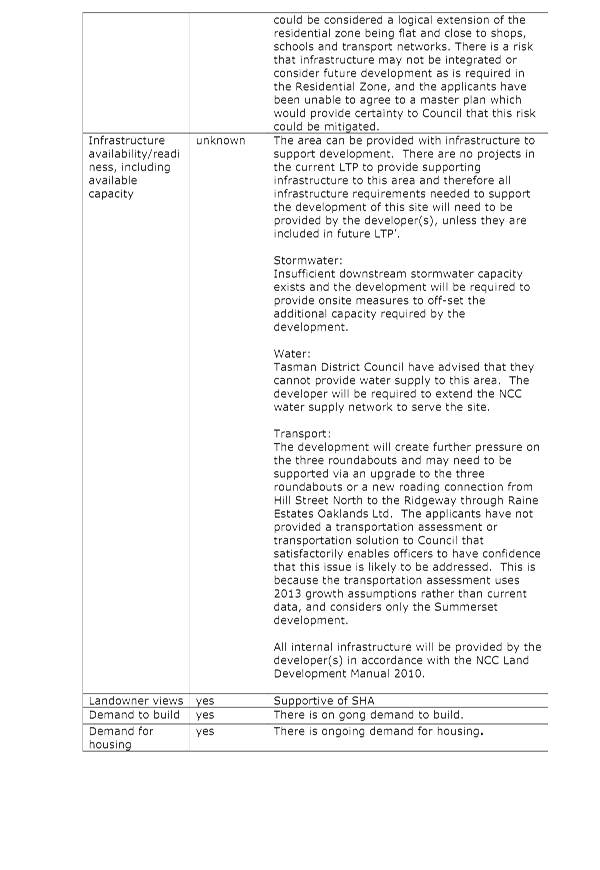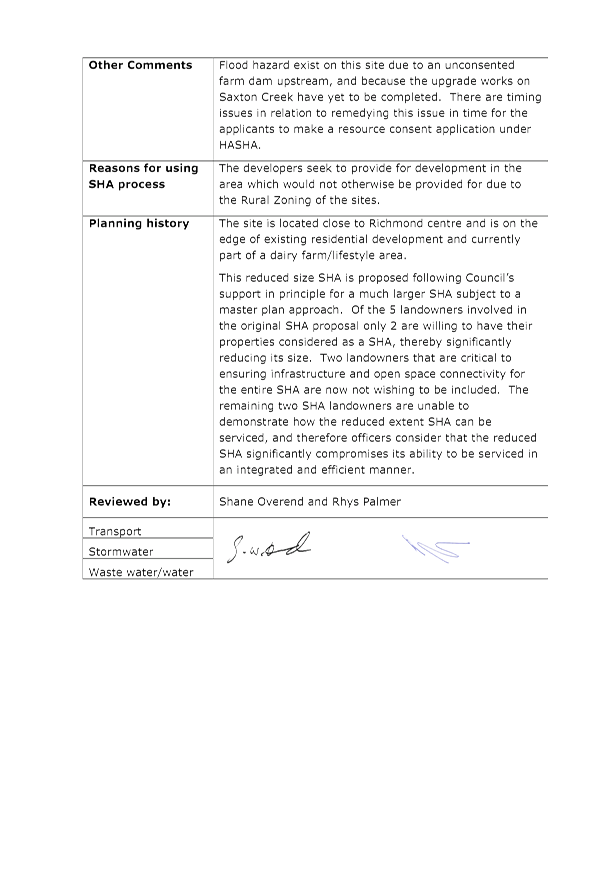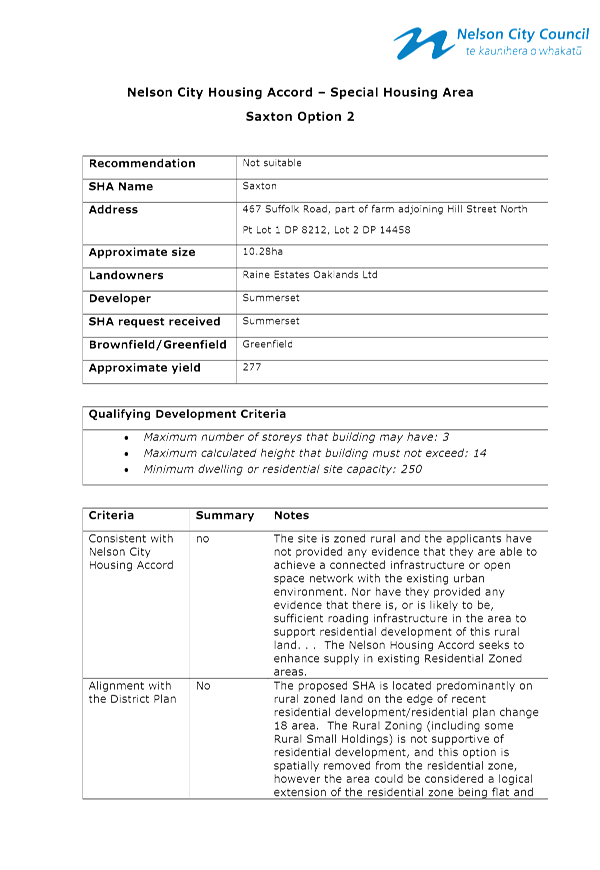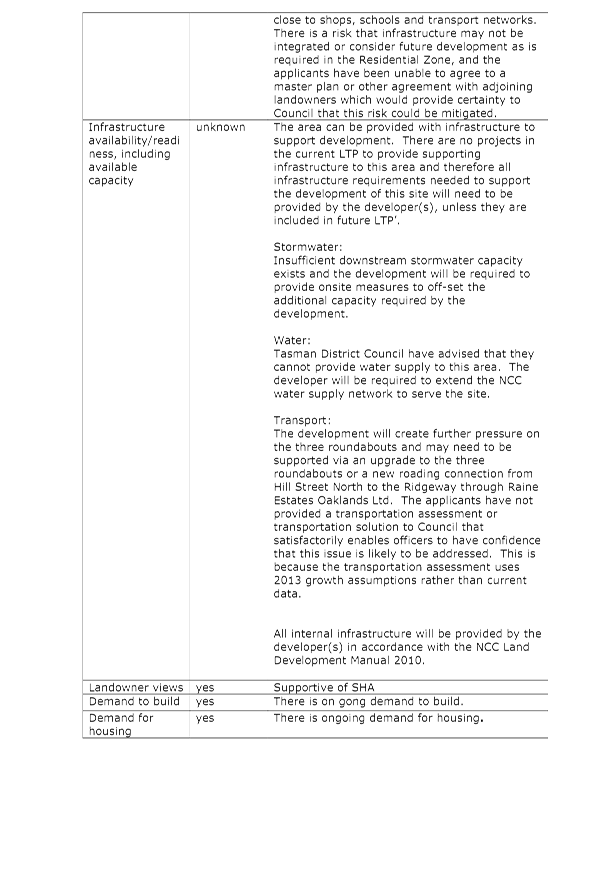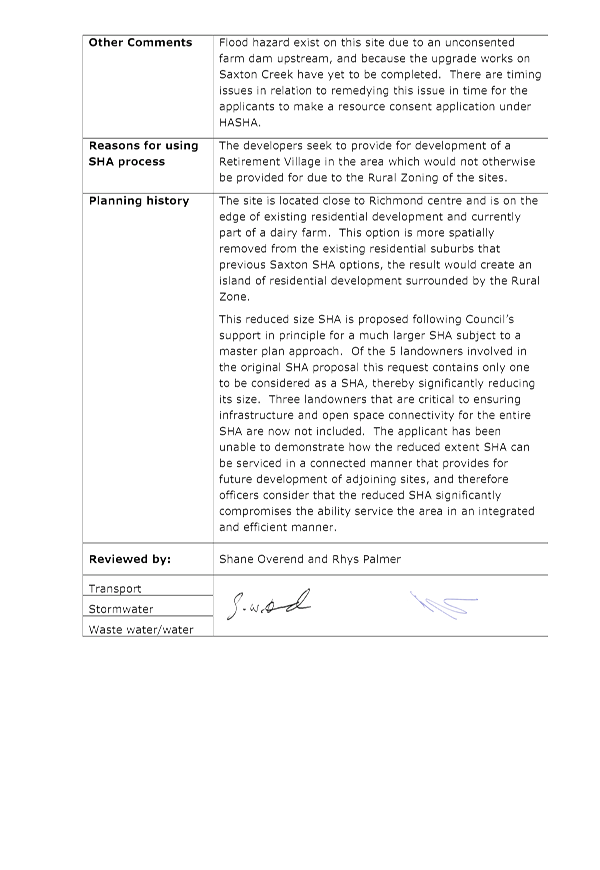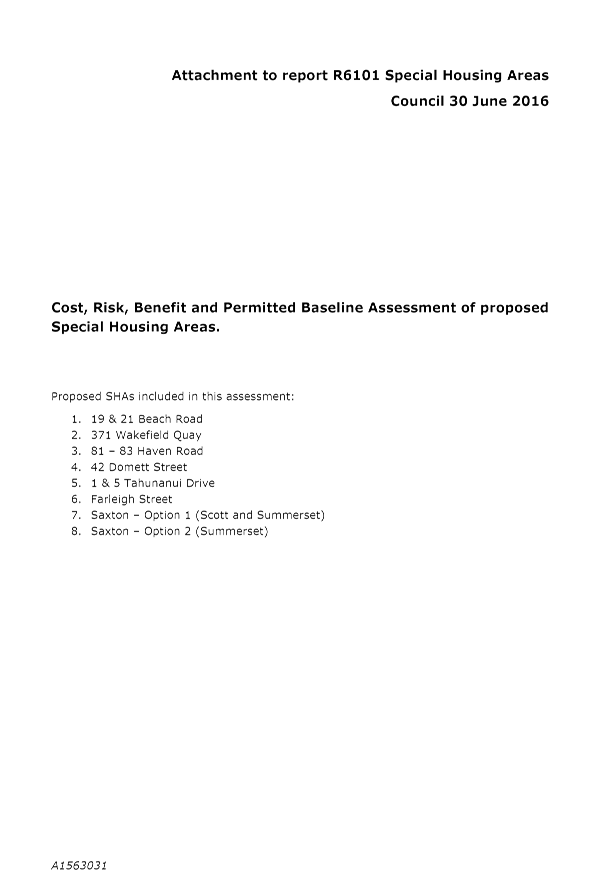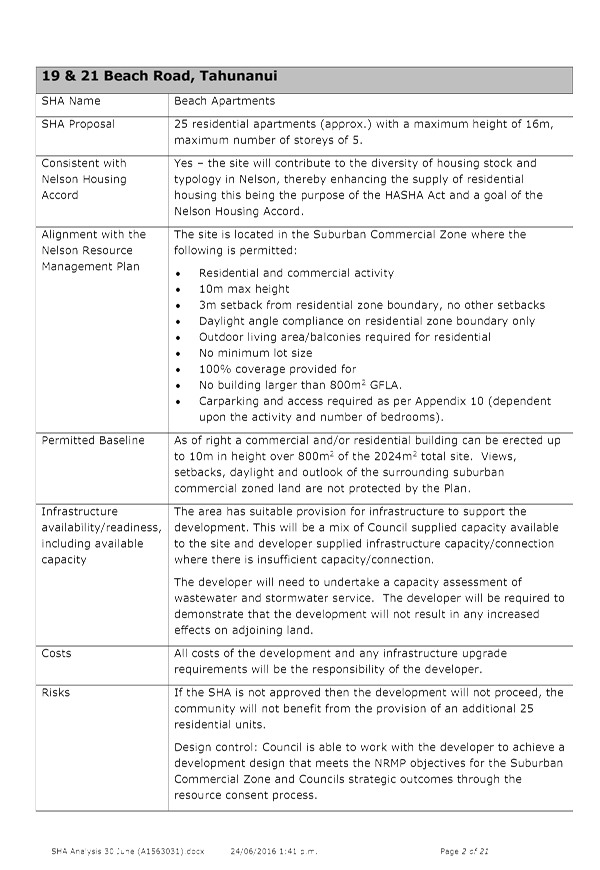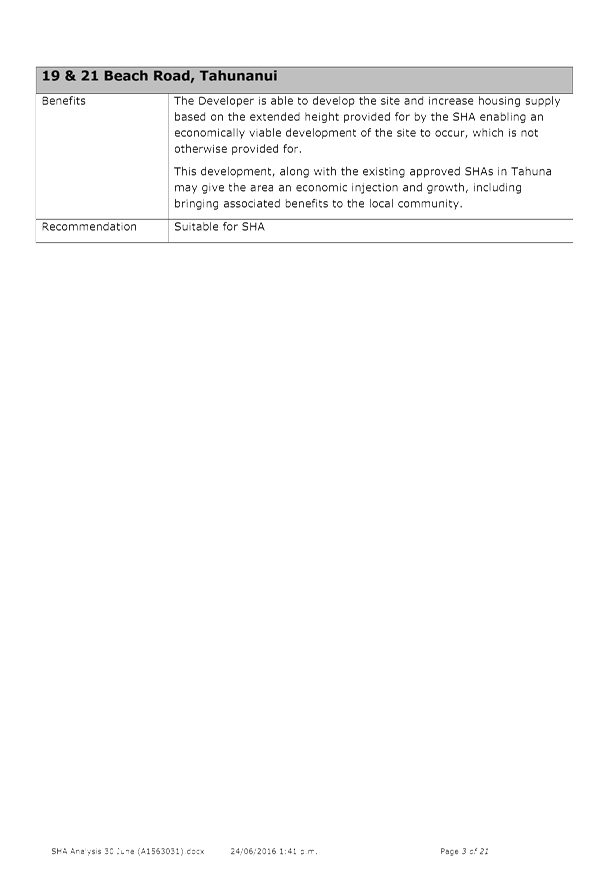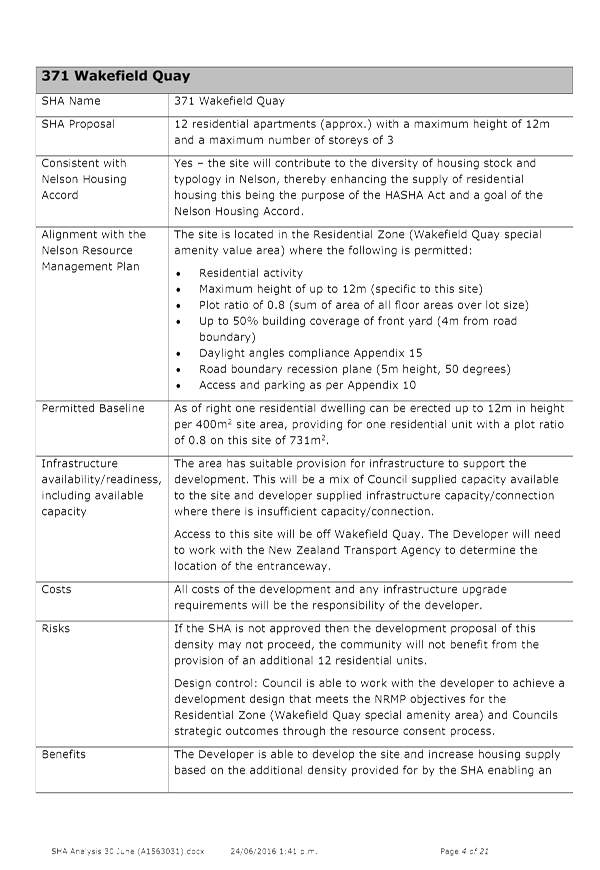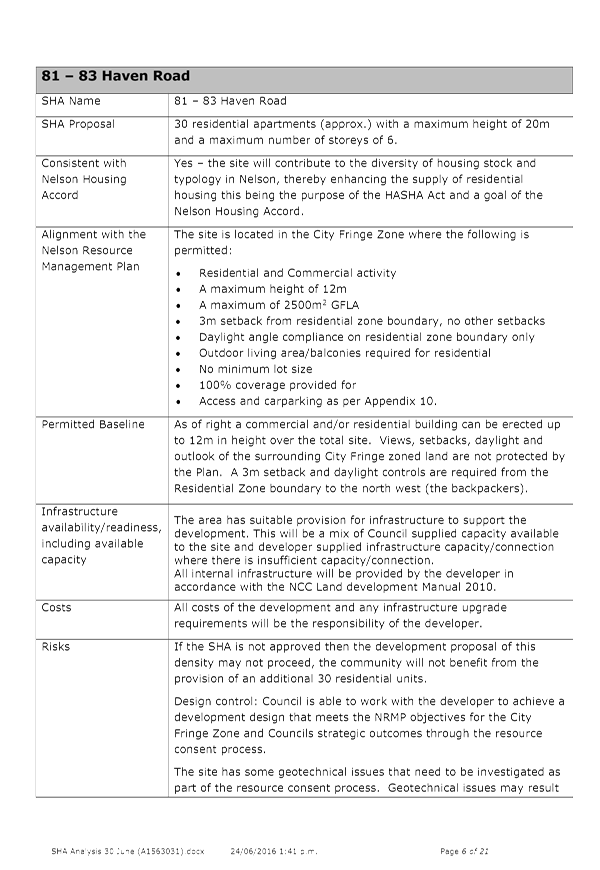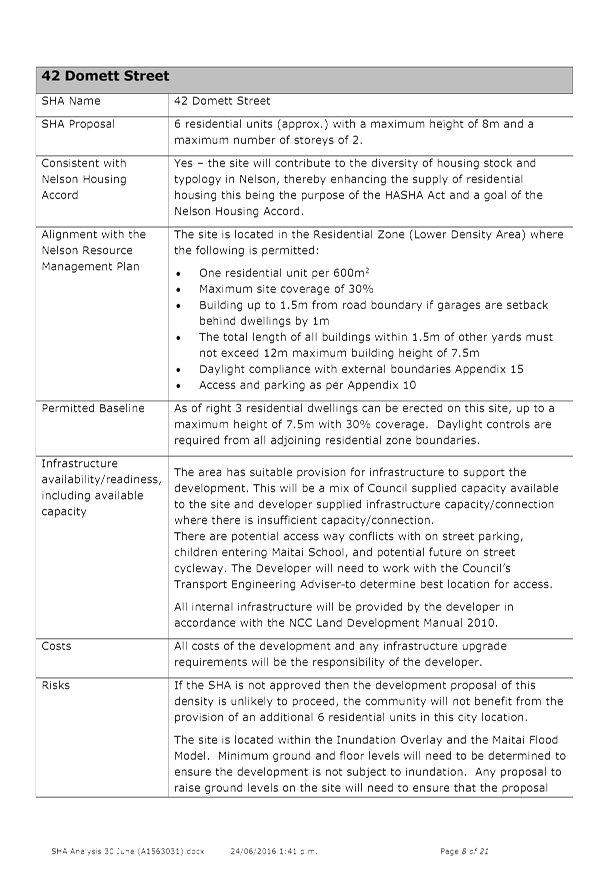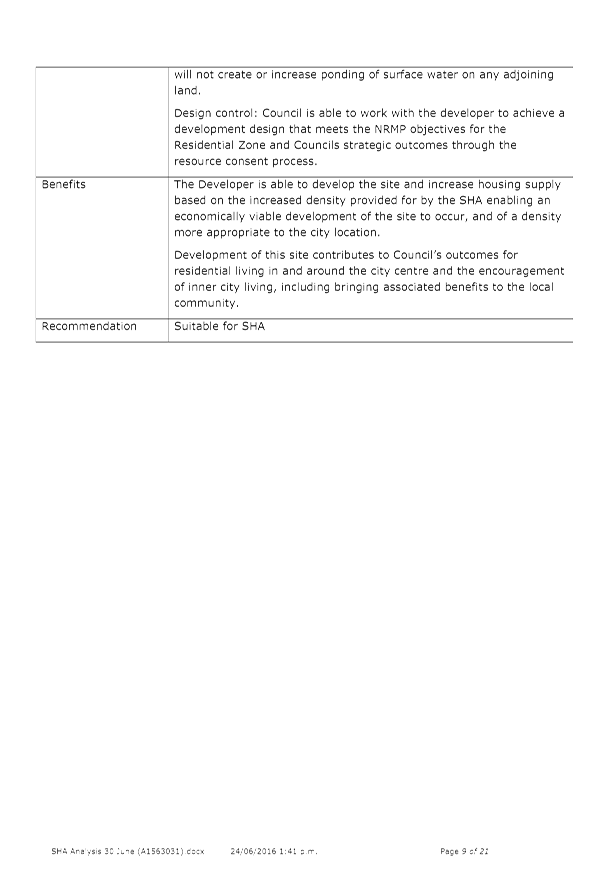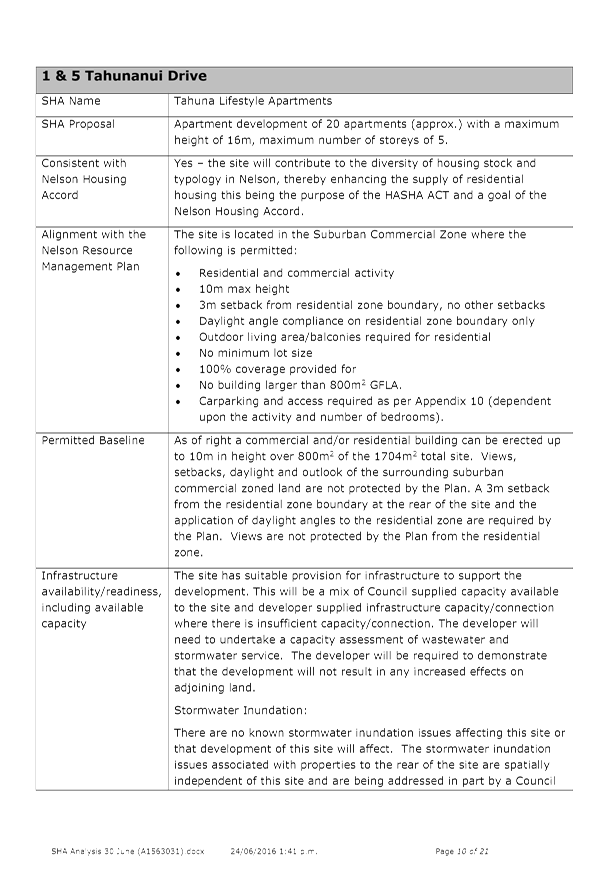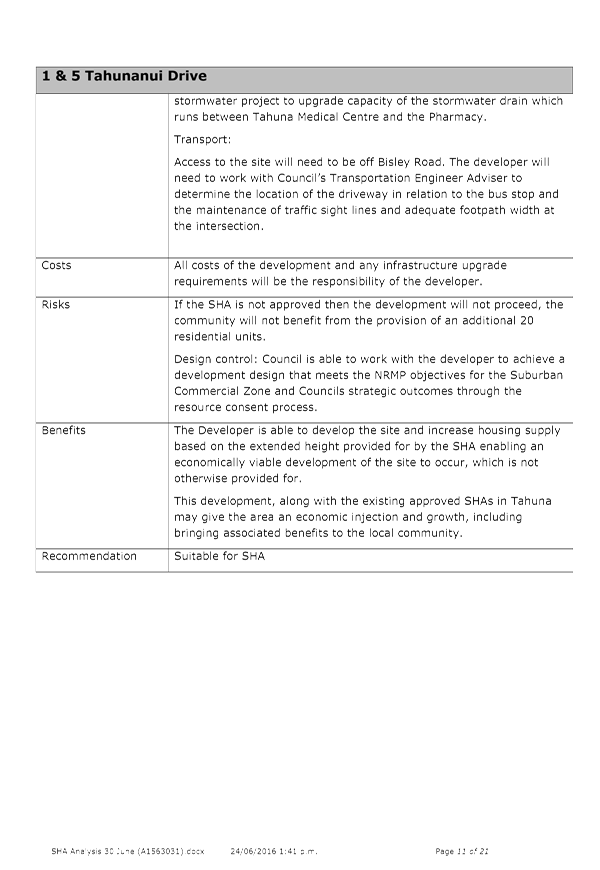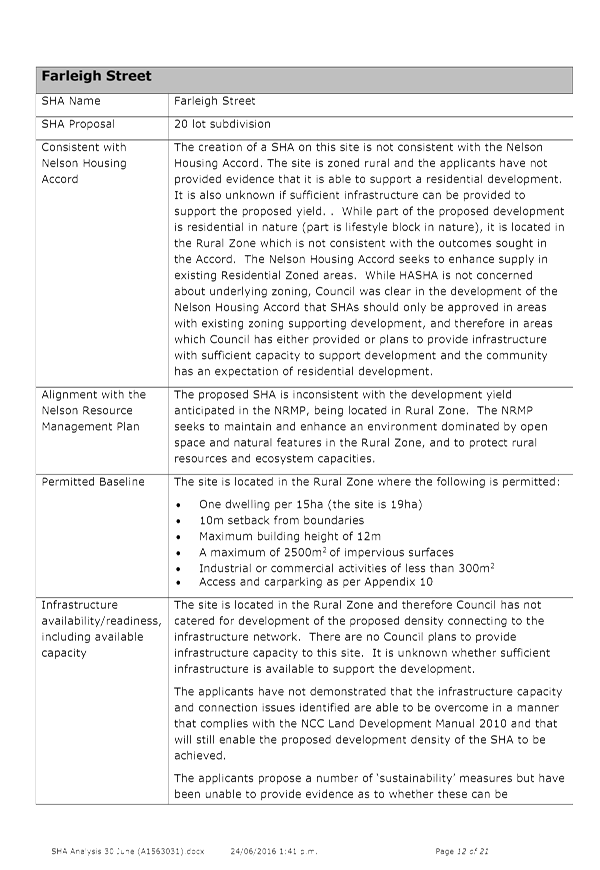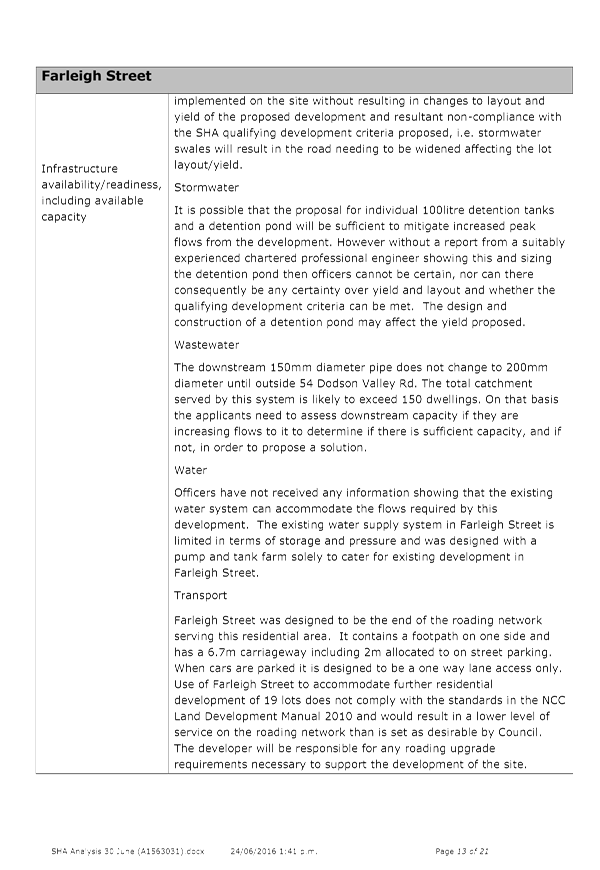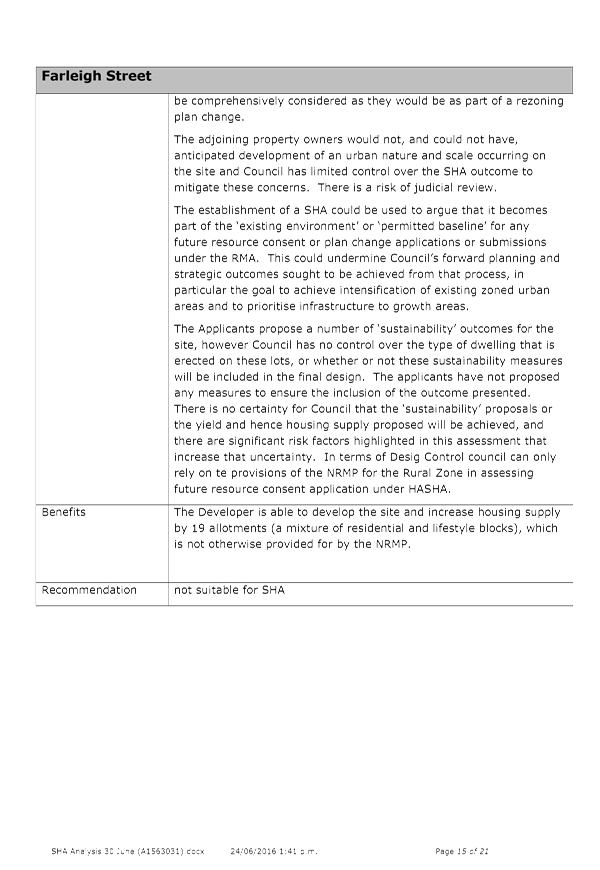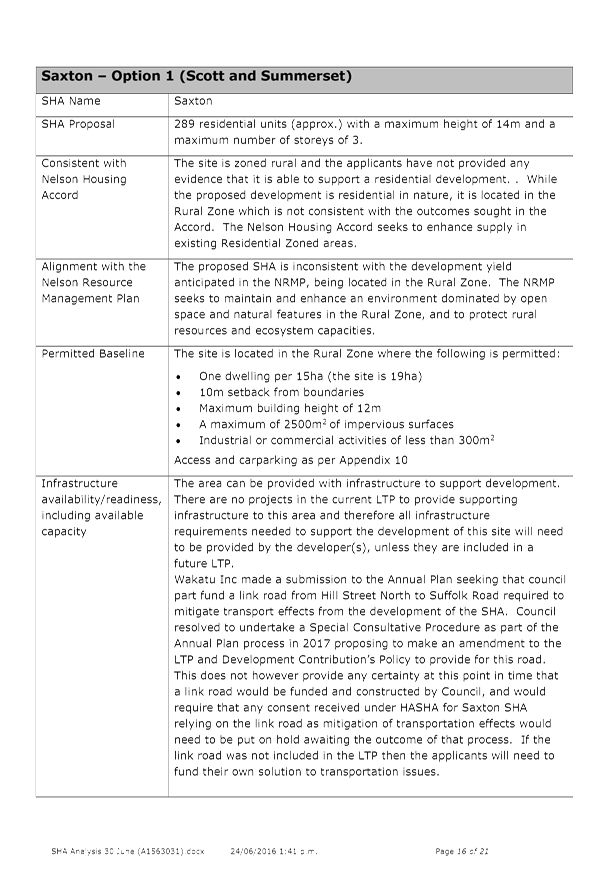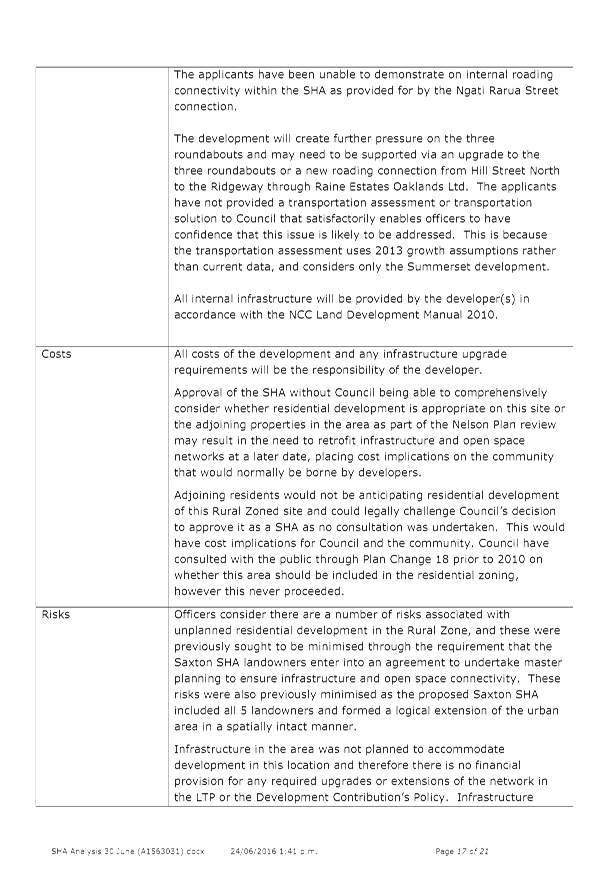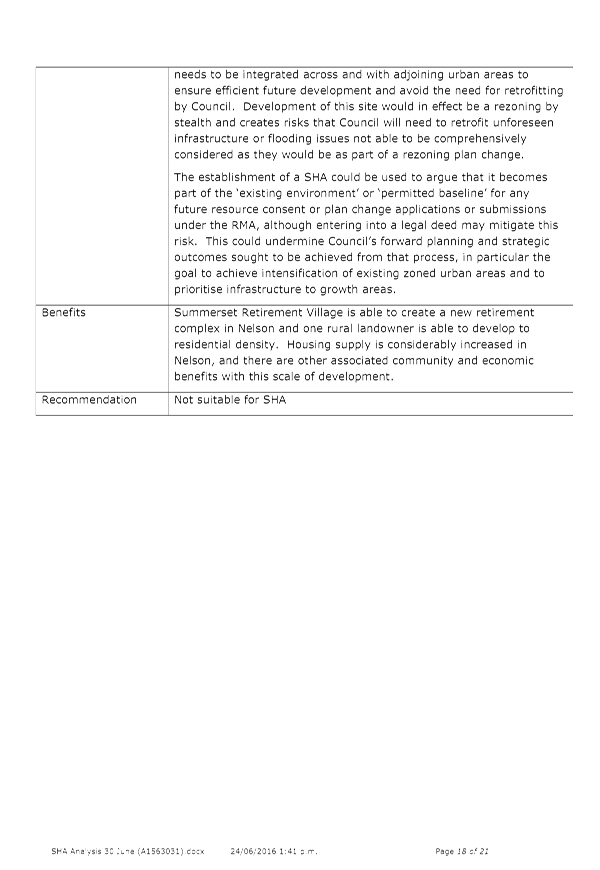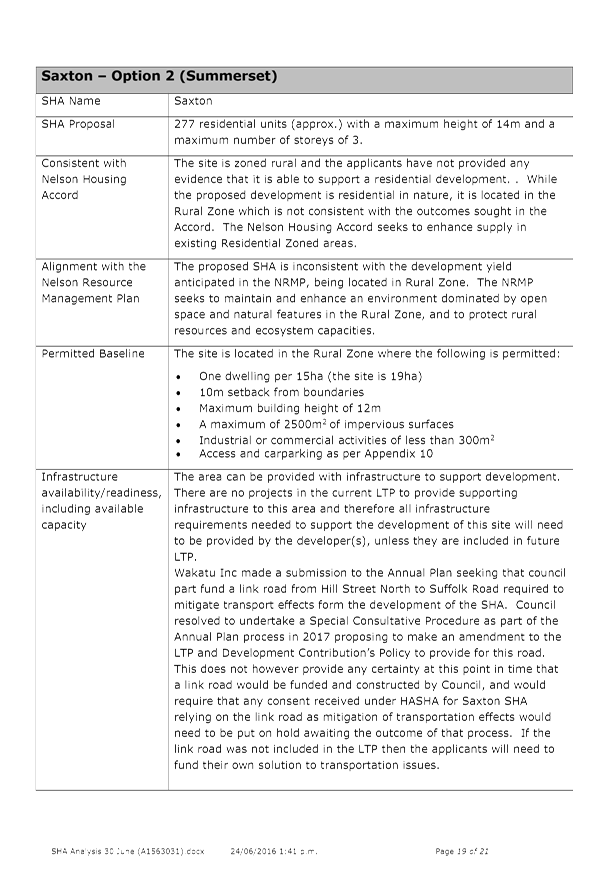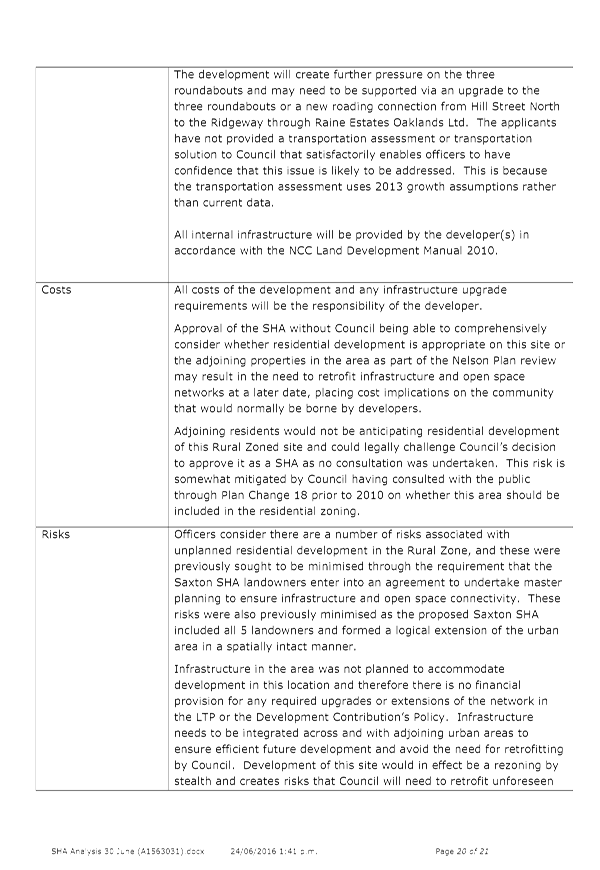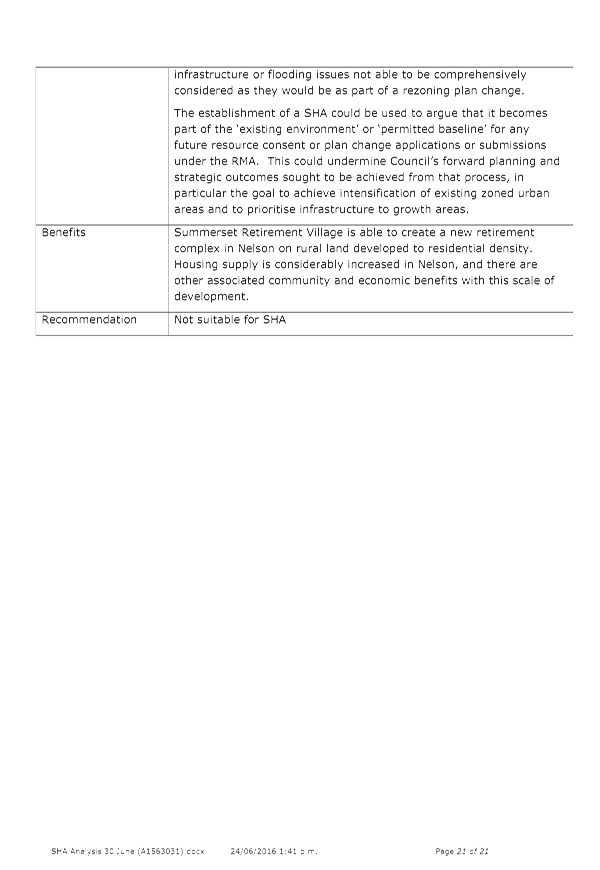 Nelson City Council
Nelson City Council
30
June 2016
Page
No.
Opening Prayer
1. Apologies
1.1 Apologies
have been received from Councillors Eric Davy and Luke Acland
2. Confirmation
of Order of Business
3. Interests
3.1 Updates
to the Interests Register
3.2 Identify
any conflicts of interest in the agenda
4. Public
Forum
4.1 Jose
Gay-Cano, Brian Riley and David Wallace - Arthouse Architects
Jose Gay-Cano will be joined by
Brian Riley and David Wallace of Arthouse Architects to speak about Special
Housing Areas – Option 7, Barcelona Lofts, 237 Haven Road.
4.2 Natalia
Harrington - Hybrid Homes and Living Ltd
Natalia Harrington, of Hybrid
Homes and Living Ltd, will speak about Special Housing Areas (Dodson Valley).
4.3 Tony
Ally from Davis Ogilivie and Bernard Downey - Saltwater Creek Investments Ltd
Tony Ally, from Davis Ogilivie,
and Bernard Downey will speak about proposing that 81-83 Haven Road be
incorporated into Special Housing Areas.
4.4 Mark
Lile and Granville Dunstan - Landmark Lile Ltd
Mark Lile and Granville Dunstan,
from Landmark Lile Ltd, will speak about Special Housing Areas (371 Wakefield
Quay).
4.5 Aaron
Smail - Summerset Group Holdings Ltd
Aaron Smail, from Summerset Group
Holdings Ltd, will speak about Special Housing Areas (Saxton).
4.6 Dolly
and Mike Brennan
Dolly and Mike Brennan will speak
about the Special Housing Areas (42 Domett Street).
4.7 Steve
Cross
Steve Cross will speak about
Special Housing Areas (1 & 5 Tahunanui Drive).
4.8 Aaron
Walton - Aaron Walton Architecture and Design Ltd, and Rachel Dodd - Arthouse
Architects Ltd
Aaron
Walton from Aaron Walton Architecture and Design Ltd, and Rachel Dodd from
Arthouse Architects Ltd, will speak about Special Housing Areas (1&5
Tahunanui Drive and 19-21 Beach Road).
5. Mayor's
Report
6. Special
Housing Areas 5 - 71
Document number R6101
Recommendation
Receive the report Special Housing
Areas (R6101) and its attachments
(A1568203, A1570355, A1565848, A1566195, A1567418, A1570343, A1569049,
A1570300, A1570087, and A1563031);
Approve
the amendment to the qualifying development criteria for the number of storeys
from 4 to 5 storeys for the Barcelona Lofts (237 Haven Road) Special
Housing Area (A1568203);
Approve
19 & 21 Beach Road (A1570355) as a potential Special Housing Area;
Approve
371 Wakefield Quay (A1565848) as a potential Special Housing Area;
Approve
81 – 83 Haven Road (A1566195) as a potential Special Housing Area;
Approve
42 Domett Street (A1567418) as a potential Special Housing Area;
Approve
1 & 5 Tahunanui Drive (A1570343) as a potential Special Housing Area;
Approve that Her Worship
the Mayor recommend all potential Special Housing Areas approved as a result of
considering report R6101 to the Minister of Building and Housing for
consideration as Special Housing Areas under the Housing Accord and Special
Housing Areas Act 2013.
7. Trafalgar
Centre - Main Building Roof Replacement 72
- 76
Document number R6110
Recommendation
Receive the report Trafalgar
Centre - Main Building Roof Replacement (R6110);
Revoke,
in accordance with Standing Order 3.9.18, the following part of the Council
resolution CL/2016/078 made on 14 April 2016:
AND
THAT funding of $250,000 be approved to install a new roof
over the current roof on the main building on the understanding that $70,000 is
already allocated in the budget and available;
Approve
funding of $240,000 to replace the roof cladding over
the main building on the understanding that $70,000 is already allocated in the
budget and is available.
Note:
·
This meeting is expected to continue beyond lunchtime. (delete as appropriate)
·
Lunch will be provided at 12.30pm. (delete as appropriate)
·
Youth Councillors Jenna Stallard and Fynn Sawyer will be in
attendance at this meeting. (delete as appropriate)
|

|
Council
30 June 2016
|
REPORT R6101
Special
Housing Areas
1. Purpose
of Report
1.1 To
approve five potential Special Housing Areas (SHAs), and approve an amendment
to an existing gazetted SHA.
1.2 To
agree that Her Worship the Mayor recommend to the Minister of Building and
Housing the SHAs and amendment for consideration under the Housing Accord and
Special Housing Areas Act 2013 (HASHA).
2. Summary
2.1 This
report seeks approval of:
· An
amendment to the qualifying development criteria of the gazetted SHA at 237
Haven Road known as Barcelona Lofts SHA;
· The
proposed SHA left to lie on the table at the 2 June and 16 June Council
meetings, being 19 & 21 Beach Road;
· The
proposed SHA at 1 & 5 Tahunanui Drive following receipt of further
information;
· Three
further proposed SHAs at 42 Domett Street, 81 – 83 Haven Road and 371
Wakefield Quay which have not been reported on before.
2.2 Two
other proposed SHA requests, Farleigh Street and two options for a reduced
extent Saxton SHA, are assessed in this report but are not recommended as
suitable. If Council wishes to recommend those SHAs, then as a minimum,
the recommendation should be subject to the developer(s) entering into a legal
deed with Council.
2.3 The
report provides a cost, risk, benefit analysis of all proposed SHAs to be
considered, along with identification of the permitted baseline (i.e. what
could currently be allowed through the Nelson Resource Management Plan) for
each site. This information is provided to aid Council’s
consideration of the SHAs. Developers have been invited to present any concepts
available for the proposed SHAs at public forum.
3. Recommendation
It is recommended that the
Council:
|
Receive the report Special
Housing Areas (R6101) and its
attachments (A1568203, A1570355, A1565848, A1566195, A1567418, A1570343,
A1569049, A1570300, A1570087, and A1563031);
Approve
the amendment to the qualifying development criteria for the number of
storeys from 4 to 5 storeys for the Barcelona Lofts (237 Haven Road)
Special Housing Area (A1568203);
Approve
19 & 21 Beach Road (A1570355) as a potential Special Housing Area;
Approve
371 Wakefield Quay (A1565848) as a potential Special Housing Area;
Approve
81 – 83 Haven Road (A1566195) as a potential Special Housing Area;
Approve
42 Domett Street (A1567418) as a potential Special Housing Area;
Approve
1 & 5 Tahunanui Drive (A1570343) as a potential Special Housing Area;
Approve that Her Worship the Mayor recommend all potential Special
Housing Areas approved as a result of considering report R6101 to the
Minister of Building and Housing for consideration as Special Housing Areas
under the Housing Accord and Special Housing Areas Act 2013.
|
If Council wishes to approve any
Special Housing Areas outside of existing residential, suburban commercial,
city centre or city fringe zonings (the urban environment), then it is
recommended that any approval for a SHA outside those zones be subject to:
|
Approve
…<insert
address>…….
potential Special Housing Area subject to the developer(s) entering into a
legal Deed with Council which requires, amongst other matters, the following:
· That the developer specify the SHA Outcome (including the
design, layout, scale, density);
· That the developer, at its sole cost, shall design,
obtain all necessary consents for, and construct any additional
infrastructure, or upgrades to the Councils infrastructure, required to
support the development of the SHA.
· That the establishment of the SHA shall not be relied on
as part of the receiving environment or permitted baseline to justify the
imposition of any objectives, policies, standards or rules relating to the
zoning of the SHA land or any applications for resource consent.
· That the Deed does not bind, restrict or in any other way
fetter the Council’s powers and obligations under the RMA, HASHA, or
any other relevant legislation.
|
4. Background
4.1 Council
entered into a Housing Accord with the Minister of Building and Housing on 11
June 2015 under HASHA.
4.2 In
order to meet its obligations under the Housing Accord, especially in relation
to targets, Council can consider using Special Housing Areas as a tool under
HASHA. Under the Accord Council can recommend the creation of Special
Housing Areas to the Minister of Building and Housing.
4.3 On
17 December 2015 Council approved for recommendation to the Minister of
Building and Housing the creation of 9 Special Housing Areas and an Order in
Council was passed by Cabinet on 15 February 2016 declaring those 9 areas as
SHAs.
4.4 On
17 December 2015 Council also approved Saxton SHA subject to a master plan
exercise in order to retain control over the practical and efficient roll out
of infrastructure for the area given its rural zoning, thereby resolving:
AND THAT Council approve option 4 (Saxton) subject to an
agreement between Council and the landowners requiring a master planning
exercise for the purpose of ensuring infrastructure and open space network
connectivity to be completed by the landowners prior to resource consent
applications being lodged;
4.5 The Saxton SHA landowners and developers have been working together to
achieve the required master plan agreement but have been unable to reach
agreement. As a result requests for a reduced extent Saxton SHA have been
received and these are discussed later in this report.
4.6 On
3 March 2016 Council approved for recommendation to the Minister of Building
and Housing the creation of an additional SHA at 45 & 47 Beach Road.
This was be approved by Order in Council on 16 May 2016.
4.7 On
2 June 2016 Council considered part of the recommendations contained in report
R5858. At that meeting, a motion was put and lost for the proposed SHA at
1 & 5 Tahunanui Drive. The remaining recommendations were left
to lie on the table with the SHA at 19 & 21 Beach Road having being moved
and seconded.
4.8 On
16 June 2016 Council considered part of the recommendations left to lie on the
table at the 2 June 2016 Council meeting, and approved the amendment to the
gazetted Ocean Lodge Special Housing Area (SHA) qualifying development
criteria. The remaining SHA requests from the 16 June report 5858 were
left to lie on the table for consideration at the 30 June Council
meeting.
4.9 In
the intervening time officers have been working with applicants to gather the
information requested by Council to assist the decision making process.
The information that has been prepared includes: a cost benefit analysis;
permitted baseline analysis; and investigation of the use of a legal deed.
SHA applicants were also invited to attend the public forum for the 30 June
Council meeting to speak in support of their proposals and enable Council to
ask questions. The time has allowed applicants to prepare concepts and
presentations for public forum.
4.10 Council has
yet to receive any resource consent applications under HASHA, however advice
from the majority of developers of gazetted SHA’s is that they are on
track to submit an application before the September 2016 deadline.
4.11 Due to the partial repeal of HASHA on 16 September
2016, and Council and Cabinet meeting schedules up to that time, this will be
the last time that Council receives a request for SHA(s) under the HASHA Act
2013.
5. Discussion
5.1 Officers
have received requests for further SHAs, and an amendment to the qualifying
development criteria for an existing SHA (Barcelona Lofts). Details of
the SHA’s proposed qualifying development criteria and infrastructure
requirements are provided in Attachments 1 to 9.
5.2 An
assessment of the costs, risk, benefits and the permitted baseline for each SHA
are provided in Attachment 10. A summary of each proposal is provided
below.
Barcelona Lofts
Amendment
5.3 Officers
have received a request from the developer of Barcelona Lofts for an amendment
of the qualifying development criteria for the existing SHA. The
amendment proposed is for an additional storey with the overall height
remaining the same. The existing and proposed qualifying development
criteria for Barcelona Lofts are summarised in the table below:
|
Existing Qualifying Development
Criteria
|
|
Maximum number of storeys
|
4
|
|
Maximum calculated height
|
20
|
|
Minimum dwelling capacity
|
9
|
|
Proposed Qualifying Development Criteria
|
|
Maximum number of storeys
|
5
|
|
Maximum calculated height
|
20
|
|
Minimum dwelling capacity
|
9
|
5.3 The amended
qualifying development criteria are proposed in Attachment 1. The reason
for the amendment is to allow a partial 5th storey which will be the
bedrooms of the units contained on the 4th level. The 5th
storey will be stepped back from the other storeys and away from the road
frontage.
19 & 21
Beach Road – Beach Apartments
5.4 Officers
have received a request from the landowner of 19 & 21 Beach Road that the
property be considered as a SHA. This site is close to the existing
gazetted Ocean Lodge and 45 & 47 Beach Road SHA’s (all being located
on Beach Road). The landowner seeks similar qualifying development
criteria for the site as that approved for the Ocean Lodge. Further
details of the proposed SHA are provided in Attachment 2 and a cost, risk,
benefit and permitted baseline analysis is provided for the proposal in
Attachment 10.
371 Wakefield Quay
5.5 Officers have
received a request from the landowner of 371 Wakefield Quay that the property
be considered as a SHA. Further details of the proposed SHA are provided
in Attachment 3 and a cost, risk, benefit and permitted baseline analysis is
provided for the proposal in Attachment 10.
81 – 83 Haven Road
5.6 Officers
have received a request from the landowner of 81 -83 Haven Road that the
property be considered as a SHA. Further details of the proposed SHA are
provided in Attachment 4 and a cost, risk, benefit and permitted baseline
analysis is provided for the proposal in Attachment 10.
42 Domett Street
5.7 Officers
have received a request from the landowner of 42 Domett Street that the
property be considered as a SHA. Further details of the proposed SHA are
provided in Attachment 5 and a cost, risk, benefit and permitted baseline
analysis is provided for the proposal in Attachment 10.
1 & 5 Tahunanui Drive – Tahuna
Lifestyle Apartments
5.8 At the 2
June Council meeting a motion was put and lost for an amendment in the
qualifying development criteria for 1 & 5 Tahunanui Drive from that
proposed in report R5858. Since that meeting the qualifying development
criteria and the availability of supporting information to address the issues
raised by Council has changed.
5.9 Officers
have received a request from the landowner of 1 & 5 Tahunanui Drive that
the property be considered as a SHA and that they will provide further
information via public forum on the anticipated design outcome for the
site. Officers have also investigated the infrastructure issues raised by
Council at the 2 June Council meeting and provide further information in
relation to those in Attachment 6 and in the cost, risk benefit and permitted
baseline analysis in Attachment 10.
5.10 Qualifying
development criteria consistent with the Beach Road SHAs is sought for this
site. The consideration of this SHA is not inconsistent with any other
previous Council decision; the proposed SHA has been amended and further
information provided.
35
Farleigh Street
5.11 Officers have
received a request from Hybrid Homes who wish to have 35 Farleigh Street
considered as a SHA. The yield qualifying development criteria proposed
has changed from that of 14 lots included in the 2 June Council report R5858
and the greater yield density proposal of 24 lots that was presented at public
forum by the applicants’ surveyor on 2 June 2016, to the now proposed 19
lots. The revised criteria are as a result of further discussions between
officers and the applicant in terms of infrastructure requirements.
Revised qualifying development criteria and a map of this rural site in
Dodson’s Valley are provided in Attachment 7. A cost, risk, benefit
and permitted baseline analysis is provided for the proposal in Attachment
10.
Saxton
SHA – Reduced Extent – Options 1 and 2
5.12 Officers have received a request from Summerset
Retirement Village (developer of Raine’s farm part of the SHA) and the
Scott’s (adjoining landowner within original Saxton SHA proposal) that
the extent of the SHA be reduced to include just the two properties and the map
and qualifying development criteria revised accordingly as shown in Attachment
8 – Saxton Option 1.
5.13 Officers have also received a request from Summerset
Retirement Village that the Saxton SHA extent be reduced to include just one
property, that part of the Raine Farm to be developed by Summerset Retirement
Village. The map and qualifying development criteria for this option have
been revised accordingly and are show in Attachment 9 – Saxton Option 2.
5.14 A cost, risk, benefit and permitted
baseline analysis is provided for both options in Attachment 10.
6. Options
6.1 The
criteria used to evaluate SHA suitability and each sites assessment are
detailed in Attachments 1 to 9, along with a map identifying each area.
The assessment criteria include the HASHA requirements that need to be
satisfied (adequate infrastructure and demand for residential housing),
consistency with the Accord, and alignment with the Nelson Resource Management
Plan.
6.2 A
cost, risk and benefit analysis including an analysis of the permitted baseline
for each SHA proposal is also provided to assist Councils decision. This
analysis is provided in Attachment 10.
A summary of the officer’s recommendation in
relation to each SHA request is provided in the table below and a summary of
the overall costs, risks and benefits of the SHAs is contained in the remaining
part of section 6 of this report:
|
Name
|
Recommendation
|
|
Barcelona
Lofts Amendment
|
suitable
|
|
19
& 21 Beach Road - Beach Apartments
|
suitable
|
|
1
& 5 Tahunanui drive - Tahuna Lifestyle Apartments
|
suitable
|
|
371
Wakefield Quay
|
suitable
|
|
81
– 83 Haven Road
|
suitable
|
|
42
Domett Street
|
suitable
|
|
Farleigh
Street
|
not
suitable
|
|
Saxton
– Option 1 (Summerset and Scott)
|
not
suitable
|
|
Saxton
– Option 2 (Summerset)
|
not
suitable
|
6.3 Some
sites already have sufficient infrastructure connections. Other sites
require additional connection and/or capacity to be provided. Where this
isn’t already a project in the Long Term Plan the necessary
infrastructure will need to be provided by the developer. Developers are
also able to seek that projects be included in the LTP and Council can choose
to consult with the community on their inclusion. The recommended SHA’s
will not result in any additional infrastructure costs on Council from that included
in the current or future Long Term Plan(s). Council can impose a
condition of resource consent requiring a financial contribution to mitigate
the effects of any SHA on the infrastructure network.
6.4 Council
has the option of approving these SHA’s and the SHA amendment for
recommendation to the Minister, or declining to recommend them to the
Minister. Council has committed through the Housing Accord to enhance
housing supply.
6.5 The
current likely yield from the ten gazetted SHA’s is 417 residential units
and if Council approves the SHA’s in this report the likely total yield
Council has enabled through the Housing Accord will be 510 residential units.
6.6 The
SHA’s will assist Council to meet the Accord targets, and to enhance the
supply of townhouses and apartments in the Nelson market, thereby enabling a
range of housing choice.
6.7 If
Council decides not to recommend the additional SHA’s and SHA amendment,
the development opportunity of some of those sites will likely be lost as
developers indicate the HASHA process enables them to overcome current economic
viability and process barriers on these sites.
6.8 The proposed SHAs at Farleigh Street and the reduced
extent(s) of Saxton are not supported by officers. The reasons for that
are outlined in the attached cost, benefit, risk and permitted baseline
analysis in Attachment 10 and are summarised generally in the bullets in 6.12
below.
6.9 The original Saxton SHA was supported by officers
subject to the landowners entering into the master plan agreement to ensure
infrastructure and open space connectivity. The requirement for this
agreement mitigated any concerns in relation to efficient and effective
servicing of the area, between adjoining properties, and reduced the risks that
Council would be responsible for retrofitting after development occurs (as has
been the case in the area of Plan Change 18).
6.10 The size of the original Saxton SHA containing 5
properties, and being the logical extension of the residential zone to the
north, mitigated concerns of the need for comprehensive planning in the area
primarily because all 5 landowners were included in the SHA, there were no
spatial gaps in the urban area to be defined. The proposed reduced extent
SHA does not offer any mitigation of these issues and risks. It
effectively provides for an island of intense development surrounded by Rural
Zoned properties with private infrastructure provision not providing for
comprehensive development of the area.
6.11 The lower yield of the reduced extent SHA means any
future commitment of Council to the construction of supporting infrastructure
(i.e. such as the link road from Hill Street North to Suffolk Road considered
during the Annual Plan) needed to support urban development in this rural area,
is less economic and places a greater financial burden on ratepayers.
6.12 Officers have investigated the potential use of a
legal deed through which to control SHA outcomes where the risks of approving a
SHA to Council and the community are potentially significant. This
applies to both the Farleigh and Saxton reduced extent SHA proposals which are
located in the Rural Zone where:
· supporting infrastructure was not planned to accommodate development in
this location and therefore there is no financial provision for any required
upgrades or extensions of the network in the LTP or the Development
Contributions Policy;
· infrastructure needs to be integrated across and with adjoining urban
areas to ensure efficient future development and avoid the need for retrofitting
by Council;
· any development should be considered in a comprehensive manner,
considering the effects and likelihood of development on any other adjoining
rural zoned land with which there is a need to integrate the provision of
infrastructure and urban form;
· the adjoining property owners would not, and could not have, anticipated
development of an urban nature and scale occurring on the Farleigh site and
Council has limited control over the SHA outcome to mitigate these
concerns. This issue is less significant for the surrounding neighbours
of the Saxton SHA having being included in the consultation for Plan change 18
and the original SHA request;
· the establishment of a SHA could be used to argue that it becomes part
of the ‘existing environment’ or ‘permitted baseline’
for any future resource consent or plan change applications or submissions
under the RMA, thereby potentially undermining the Nelson Plan review.
6.13 A legal deed could address the above issues, but is
considered to be an aspirational (designed to set the tone) agreement between
the developer and Council. It provides some assurance in terms of the
risks of approving a SHA in the Rural Zone, in that it provides a degree of
certainty in relation to the outcome, where costs lie and the intention that
the SHA should not be relied upon in RMA processes. The Deed concept does
have limitations in that while it sets out the intentions of both parties,
should a developer default, then Council would need to take legal proceedings
to ensure the Deed is enforced. Such proceedings come with their own
costs and risks.
6.14 Entering into a legal deed for SHAs in the Rural Zone
does not however overcome the fact that there has been no public consultation
over the use of SHAs in the Rural Zone. The community can expect that
development will occur on sites with urban zoning. However existing
residents adjoining the Rural Zone in Farleigh Street would not be anticipating
development of a residential nature to occur on those sites, and Council has
not sought the views of those potentially affected by such a proposal.
6.15 In the case of the Saxton SHA, residential development
of the Rural Zone area the SHA is located in was subject to public consultation
as part of the work informing Plan Change 18 prior to 2010. While Council
has sought the views of those potentially affected by urban development in the
area in the past, and the views of those in the first Saxton SHA proposal are
known, the current views of those potentially affected in the wider Saxton
urban area are not known.
6.16 In recommending SHAs in existing areas zoned to permit
residential development of an urban density (i.e. in the Residential Zone,
Inner City Zone, City Fringe Zone and Suburban Commercial Zone) adjoining landowners
would be anticipating such development. In assessing those SHA
applications officers are able to rely upon the permitted activity development
rights afforded to those Zones by the NRMP, and that any breach of those will
be considered on its merits through the resource consent process provided for
by HASHA. That HASHA assessment process requires consideration of the
intent of those Zones (their objectives, policies and rules) contained in the
NRMP as well as urban design principles set out by the MFE Urban Design
Protocol. This assessment is albeit of less weighting than that of
enhancing housing supply, thus the Governments intent behind HASHA. HASHA
also states that Council’s regulatory unit may notify adjacent property
owners as part of that assessment process.
7. Conclusion
7.1 This
report seeks approval of:
· An
amendment to the qualifying development criteria of the gazetted SHA at 237
Haven Road known as Barcelona Lofts SHA;
· The
proposed SHA left to lie on the table at the 2 June and 16 June Council
meetings, being 19 & 21 Beach Road;
· The
proposed SHA at 1 & 5 Tahunanui Drive following receipt of further
information;
· Three
further proposed SHAs at 42 Domett Street, 81 – 83 Haven Road and 371
Wakefield Quay which have not been reported on before.
7.2 Two
other proposed SHA requests, Farleigh Street and two reduced extent Saxton SHA
options, are assessed in this report but are not recommended as suitable.
If Council wants to recommend those SHAs, then as a minimum, the recommendation
should be subject to the developer(s) entering into a legal deed with Council.
Lisa
Gibellini
Development
Projects Planner
Attachments
Attachment 1: A1568203
SHA Barcelona Lofts (amendment)
Attachment 2: A1570355
SHA 19 & 21 Beach Road
Attachment 3: A1565848
SHA 371 Wakefield Quay
Attachment 4: A1566195
SHA 81-83 Haven Road
Attachment 5: A1567418
SHA 42 Domett Street
Attachment 6: A1570343
SHA 1 & 5 Tahunanui Drive
Attachment 7: A1569049
SHA 35 Farleigh Street
Attachment 8: A1570300
SHA Saxton Option 1
Attachment 9: A1570087
SHA Saxton Option 2
Attachment 10: A1563031
SHA Cost, Risk, Benefit and Permitted Baseline Analysis
|
Important considerations for decision making
|
|
1. Fit
with Purpose of Local Government
The recommendations in this report are consistent
with the purpose of local government and directly seek to achieve meeting
“the current and future needs of communities for good-quality local
infrastructure, local public services, and performance of regulatory
functions in a way that is most cost-effective for households and
businesses”
|
|
2. Consistency
with Community Outcomes and Council Policy
The
recommendations align with the direction set by Council for SHA’s at
the 17 December 2015, 3 March 2016, 2 June and 16 June Council meetings and
the Nelson Housing Accord. The recommendations are also consistent with
achieving greater housing choice goals sought through Council’s
Strategic documents, especially the strategic outcomes driving the Nelson
Plan review.
|
|
3. Risk
HASHA, SHAs and Nelson Housing Accord provides an
opportunity for Council to facilitate residential development in urban areas
that are otherwise not occurring due to economic viability and process
issues. If SHAs recommended in this report are not approved then there
is a risk that development of those sites is not enabled, and the goal of
furthering the supply of residential units as part of the Housing Accord is
not met. If SHAs not recommended suitable in this report are approved,
then there is a risk that development occurs in an individual site basis
requiring Council will need to fund and retrofit infrastructure and opens
space networks in the future, as well as a risks of legal challenge by
residents in the area not anticipating residential development in the Rural
Zone.
|
|
4. Financial
impact
All infrastructure required to serve the SHAs is to
be provided by the developer, unless it is a project that is scheduled in the
Long Term Plan and funded via Development Contributions.
All costs of the processing of SHA resource consent
applications will be funded by the applicant.
|
|
5. Degree
of significance and level of engagement
This matter is of low to medium significance because
it does not significantly impact the community. The SHAs recommended in this
report are all located in existing zoned residential, suburban commercial, or
city fringe areas where development of the site is anticipated by the
community. The establishment of SHAs recommended in this report will result
in subsequent resource consent applications under HASHA for such development,
and at that time engagement with adjacent landowners will occur if
Council’s regulatory arm considers that they are affected.
Overall, the establishment of SHAs recommended in this report will assist
with increasing housing supply in Nelson which will be of benefit to the
wider community.
|
|
6. Inclusion
of Māori in the decision making process
Maori have not been consulted on this matter.
|
|
7. Delegations
No committee of Council has delegations for the
Housing Accord and Special Housing Areas Act 2013 and therefore the matter
needs to be considered by full Council.
|
|

|
Council
30 June 2016
|
REPORT R6110
Trafalgar
Centre - Main Building Roof Replacement
1. Purpose
of Report
1.1 To
provide further detail and recommendation on replacing the roof cladding over
the Trafalgar Centre main building.
2. Summary
2.1 A report that included this item
was considered by Council at its meeting on 14 April 2016. It relates to
renewing the roof over the main building of the Trafalgar Centre.
2.2 At that meeting Council resolved to
place new roof cladding over the existing roof caladding. A further assessment
on future maintenance implications of the recommended option plus recent
developments on roof loadings has resulted in a change of thinking. This report
outlines those assessments and recommends removing the old cladding and
replacing it with new cladding.
3. Recommendation
It is recommended that the
Council
|
Receive the report Trafalgar
Centre - Main Building Roof Replacement (R6110);
Revoke,
in accordance with Standing Order 3.9.18, the following part of the Council resolution
CL/2016/078 made on 14 April 2016:
AND
THAT funding of $250,000 be approved to install a new roof
over the current roof on the main building on the understanding that $70,000
is already allocated in the budget and available;
Approve
funding of $240,000 to replace the roof cladding
over the main building on the understanding that $70,000 is already allocated
in the budget and is available.
|
4. Background
4.1 As stated in the report 14 April
2016, severe corrosion was identified under the overlaps of the roof cladding
when sections of roofing were removed to install the new internal roof bracing.
This corrosion is sufficiently severe that even with treatment and repainting,
the roof cladding may only last another 10-20 years.
4.2 The three options presented to
Council were;
· Roof
Option 1 – Lift the roofing and treat the corrosion under the
overlaps and repaint the roof. This had an estimated cost of $210,000. This
would only extend the life of the roof 10-20 years.
· Roof
Option 2 - Remove the old cladding and replace with new cladding.
This had an estimated cost of $310,000.
· Roof
Option 3 - Treat the corrosion under the laps on the old roof, then put new
battens across the old roof and install a new roof over the top. This had an estimated
cost of $320,000.
4.3 Council considered the three
options and passed the following resolution based on the advice and
recommendations (CL/2016/078);
AND THAT
funding of $250,000 be approved to install a new roof over the current roof on
the main building on the understanding that $70,000 is already allocated in the
budget and available.
5. Discussion
5.1 In the April 2016 report it was
stated that there were potential health and safety benefits in putting a new
roof cladding over the old cladding. The report also stated potential
improvements in insulation and sound proofing from external weather events. Although
these offered advantages, other factors have been given further assessment and
do outweigh these advantages.
5.2 The first factor is the long term
viability of the new roof cladding built over the old cladding. Attention
has been drawn to increased risk of condensation between the two layers of roof
cladding. Whilst this may not be noticeable in the first few years it is likely
that condensation could accelerate corrosion in the already corroded older roof
cladding. If and when any repairs are required will require removing the new
roof cladding over the top. The chances of the new roof lasting at least
another 50 years could be compromised.
5.3 The second factor is the additional
loading on the roof structure. Since the April 2016 report further
investigations into the roof loadings have indicated that the additional
loading of a second layer of roof cladding could compromise the opportunities
to hang sound and lighting equipment from the roof internally. It could also
limit the flexibility around implementing the proposed ‘theatre’
option within the Trafalgar Centre.
5.4 With this additional information it
is considered that removing and replacing the roof cladding may be more
cost-effective in the long-term. Both options have similar estimates so there
are no cost implications.
5.5 The proposed option involves
exposing the roof lining and interior to the weather, therefore it is
necessarily that it be undertaken during appropriate weather conditions. At
this stage it is not likely to be undertaken before September this year.
5.6 There are also additional health
and safety risks with removing the old roof compared to the other two options,
however the contractor has confirmed that a methodology can be implemented that
manages those risks.
5.7 It is therefore recommended that
Council revoke the April 2016 resolution to install a new roof cladding over
the top the current roof cladding and adopt the option of removing the old roof
cladding and replacing it with new roof cladding.
6. Options
6.1 The following table outlines the
advantages and disadvantages of each of the options listed.
|
Option 1: Treat Corrosion and Paint Current Roof
|
|
Advantages
|
· It
is a cheaper option in the short term.
|
|
Risks and Disadvantages
|
· The
roof cladding would potentially need to be renewed in the next 10-20 years.
· In
the longer term not considered a cost-effective option.
|
|
Option 2: Remove and Replace Roof Cladding
|
|
Advantages
|
· New
roof cladding would have a life of at least 50 years
|
|
Risks and Disadvantages
|
· A
higher cost up front than Option 1 but considered more cost-effective in the
long term.
· Health
and Safety risks with removing and replacing the roof cladding
· The
work is weather dependant
|
|
Option 3: Install new roof cladding over the top of
the old roof cladding
|
|
Advantages
|
· New
roof cladding would extend the life of the roof compared to Option 1
· Potential
improvements in insulation and sound proofing from external weather events
· Health
and safety risks during construction are lower than in Option 2
|
|
Risks and Disadvantages
|
· Dual
skin cladding is likely to increase condensation leading to increased
corrosion increasing the chance of maintenance
· Future
maintenance compromised with a dual cladding roof
· The
increased loadings will compromise the opportunities to hang sound and
lighting equipment internally from the ceiling
|
7. Conclusion
7.1 The conclusion is that instead of
installing battens and new cladding over the current roof of the main building
of the Trafalgar Centre, that the current roof cladding be removed and replaced
with new roof cladding at an estimated cost of $310,000.
Richard
Kirby
Consulting
Engineer
Attachments
Nil
|
Important considerations for decision making
|
|
1. Fit
with Purpose of Local Government
This project fits in with the purpose of local
government as it contributes to meeting the current and future needs of
communities for good-quality local infrastructure and local public services.
|
|
2. Consistency
with Community Outcomes and Council Policy
This report is in line with Council’s position
of re-opening the Trafalgar Centre as it is outlined in its Long-Term Plan
2015/25.
|
|
3. Risk
The risks are outlined in the report and the risks
associated with the recommended option have been highlighted and will be
managed during construction.
|
|
4. Financial
impact
The recommended option can be undertaken within the
funding that has been allocated.
|
|
5. Degree
of significance and level of engagement
Council signalled its intention to re-open the
Centre as part of its 2014/15 Annual Plan. Council has also included
the project in its Long-Term Plan 2015-25. No consultation on the
matters raised in this report has been undertaken. It is of low significance
because it is primarily about replacing the roof of the Trafalgar Centre,
therefore it is not considered necessary to undertake any consultation.
|
|
6. Inclusion
of Māori in the decision making process
Consultation with Maori occurred through the Annual
and Long Term Plan processes.
|
|
7. Delegations
Council resolved in June 2014 for updates to be
reported to full Council.
|


 Nelson City Council
Nelson City Council

























